Malignant Catarrhal Fever in cattle is a highly fatal infectious viral disease. The disease is characterized mainly by sudden high fever, catarrhal mucopurulent inflammation of the upper respiratory and alimentary epithelium, keratoconjunctivitis, enlargement of lymph nodes, and meningoencephalitis. The disease is fatal, and in unattended cases, the mortality may reach up to 100%. The morbidity rates may vary from 20-50% in susceptible herds, and most of the cases are seen in the late winter or spring months.
Important Information on Malignant Catarrhal Fever in Cattle
Bovine Malignant Catarrh is an infectious viral disease in cattle and other domestic animals. The disease is highly fatal in cattle and buffaloes, and unattended animals may die suddenly. In addition, the sheep, wildebeests, and wild ruminants act as carriers of the virus. In my article, I shall discuss the essential information about the disease for the farm owner and veterinarians.
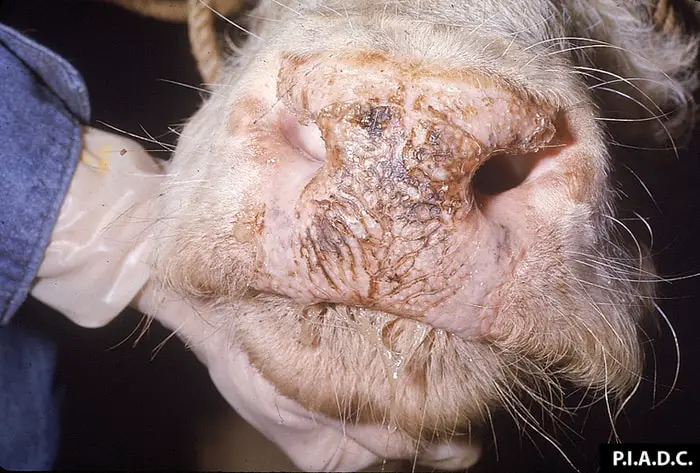
Epidemiology of MCF in Cattle
All age groups of cattle and buffaloes are susceptible to Malignant Catarrhal Fever, but buffaloes are more susceptible than cattle. The disease is transmitted by the inhalation of contaminated aerosol and ingestion of contaminated food and water. The virus is not transmitted by direct contact. The wildebeests, sheep, and wild ruminants are served as the reservoir of the disease.
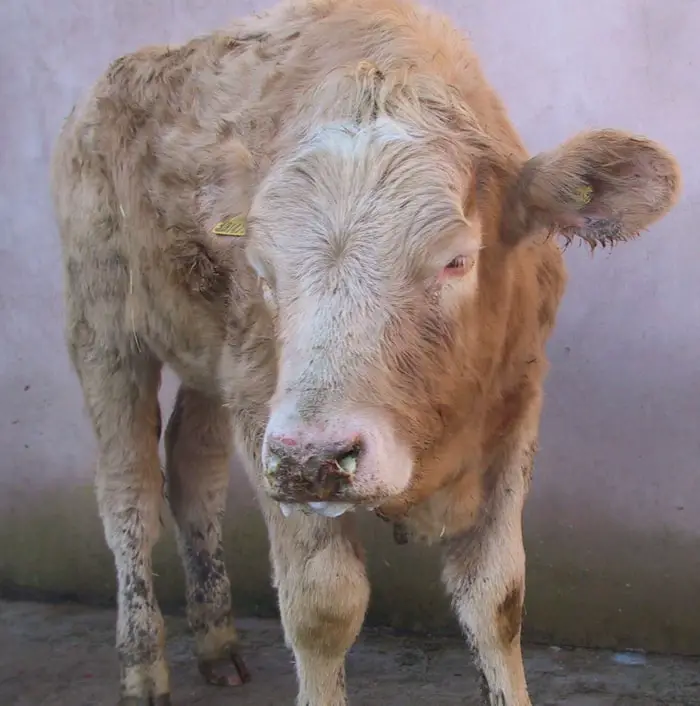
Causes of Malignant Catarrhal Fever
The Bovine Herpes virus causes bovine malignant Catarrhal fever. There are two forms of the disease caused by Alecephalic Herpesvirus-1 (AHV-1), which is transmitted from Blue Wildebeests. The virus has been named Bovine Herpesvirus-3 also. The other form is associated with the domestic sheep and is caused by Ovine Herpesvirus-2 (OHV-2).
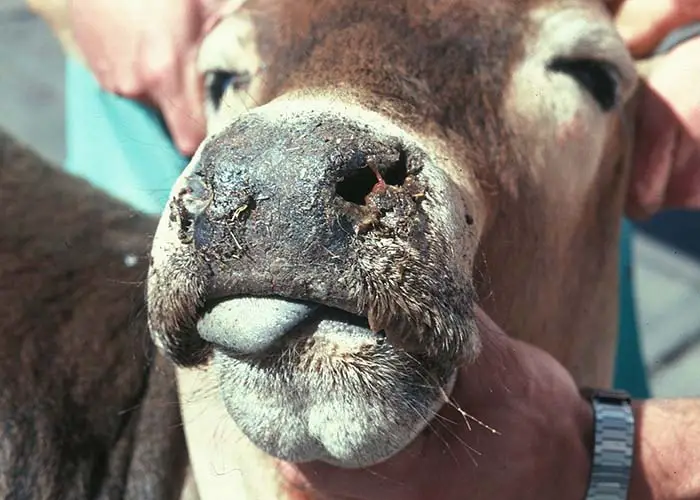
Pathogenesis of Bovine Malignant Catarrh
The incubation period of the MCF in cattle varies from 3 weeks to 6 months. The pathogenesis of the disease are:
- The virus enters the host body through inhalation of aerosol or ingestion of feed contaminated with nasal or ocular discharge.
- MCF is a multisystemic disease characterized by lymphoid hyperplasia and widespread vascular epithelial and mesothelial lesions morphologically associated with lymphoid cells.
- The clinical and pathological changes of lymphoid hyperplasia and catarrhal inflammation are associated with the infection of the larger granular lymphocytes, or “natural killer” cells by the virus.
- The epithelial erosions and keratoconjunctivitis are associated with the involvement of vascular adventitia.
- The other changes are encephalitis and synovitis.
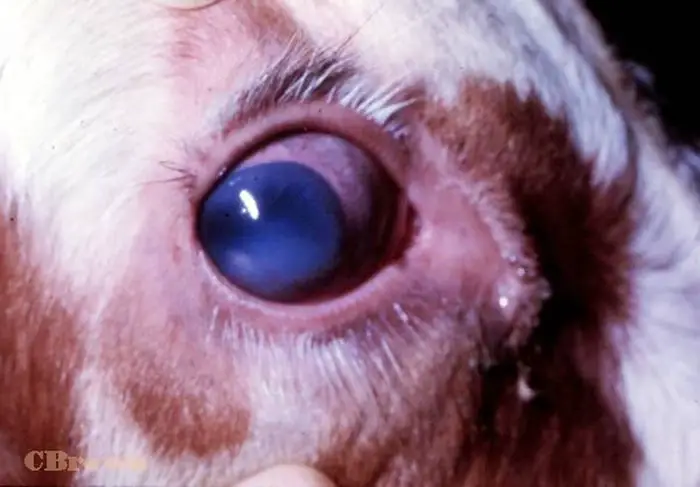
Clinical Signs and Symptoms of MCF in Cattle
There are three forms of the disease; head, eye, and gastro-intestinal form. In the head form:
- Animals are suddenly infected and reveal high fever (106° F).
- Anorexia.
- Rapid Pulse rate.
- Low milk yield.
- Profuse purulent nasal discharge.
- Severe dyspnea.
- Discrete local areas of necrosis are seen on the hard palate, gums, and gingivae, and the animal moves the jaw carefully due to pain.
- The skin of the muzzle is extensively involved, and it is excessive salivation.
- Nervous signs like weakness of legs, incoordination, muscle tremors, nystagmus, head pushing, paralysis, and convulsions may also be seen.
- The animal passes the herd to profuse diarrhoeic feces depending on the stage of the disease.
- The cornea’s opacity is commencing as a narrow, grey ring at the corneoscleral junction and spreading centripetally.
- In lingering cases, pealing off the skin and sloughing off the horns are very common.
- In most cases, animals die within 7-12 days of infection due to acute encephalitis.
The dietary form is also known as peracute form, lasts for 1-3 days, and is difficult to detect. Tn this form:
- The animals reveal a high fever.
- Dyspnea.
- Acute gastroenteritis.
- There is marked diarrhea, haemoconcentration, and loss of weight.
Pathological Lesions of Bovine Malignant Catarrh
The pathological lesions are as follows:
- There is tissue necrosis and lymphoproliferation with an accumulation of lymphoid cells in the interstitial spaces of non-lymphoid organs and enlargement of lymph nodes, particularly in the paracortical zones.
- The lover is swollen and shows evidence of degeneration.
- There are lesions of hemorrhagic necrosis and ulceration in the epithelium of the urinary bladder.
- The opacity of the eye.
- The raised white foci on the surface of the kidneys.
- The other lesions are catarrhal enteritis.
- Perivascular and mononuclear cell cuffing in most of the organs.
- The erosions of the tips of the cheek papillae, especially in the commissures, are widespread.
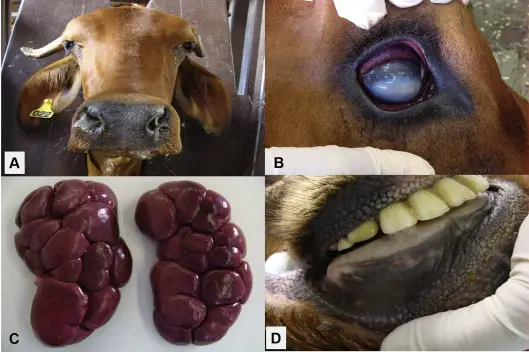
Diagnosis of Malignant Catarrhal Fever in Cattle
There are no definitive diagnostic tests available, but it can be done through the history and the clinical signs and confirmed by necropsy lesions.
- Clinically, a presumptive diagnosis can be made when the nasal, oral, and ocular lesions are observed with the persistence of high temperature.
- The corneal opacity of centripetal nature is essential in the diagnosis.
- Isolation of the virus is difficult, so serological tests could not be developed.
- The disease is confirmed by the Polymerase Chain Reaction (PCR) test.
- ELISA
Differential Diagnosis of Bovine Malignant Catarrh
The disease should be differentially diagnosed from the following diseases:
- Mucosal disease, Rinderpest, and Infectious Stomatitis where there will be no ocular lesions.
- Infectious Bovine Rhinotracheitis, which is not fatal and recovery is rapid compared to Bovine Malignant Catarrh.
- Pneumonic Pasteurellosis, where there will be no oral, nasal, and ocular lesions, and the disease will respond to antibiotics.
- Viral Encephalitis- Sporadic Bovine Encephalomyelitis, where there will be no epithelial lesions.
- Mycotic Dermatitis, there will be no oral lesions.
- Photosensitive Dermatitis, where the lesions will not spread to the mucosa.
Treatment of Malignant Catarrhal Fever in cattle
There is no specific treatment for Bovine Malignant Catarrh.
- Non-steroid anti-inflammatory drugs can be given to relieve pain and discomfort.
- You can use a broad-spectrum antibiotic to prevent secondary bacterial infection.
- Intravenous fluid therapy has a positive value in treatment.
Prevention and Control of Bovine Malignant Catarrh
The preventive measures that you can follow are:
- The sick animals should be isolated, and separate care is undertaken.
- In areas where the disease occurs frequently, the source of infection should be avoided.
- The sheep and wildebeest should not be rared together.
Concluding Remarks on Malignant Catarrhal Fever in Cattle
MCF in cattle is a significant viral disease of the cattle population. The disease is highly fatal in untreated animals. The disease is transmitted by the sheep and wildebeests that serve as reservoirs of the disease. However, the proper management and care make a complete recovery from the disease.